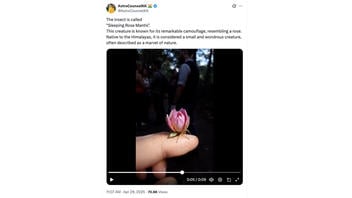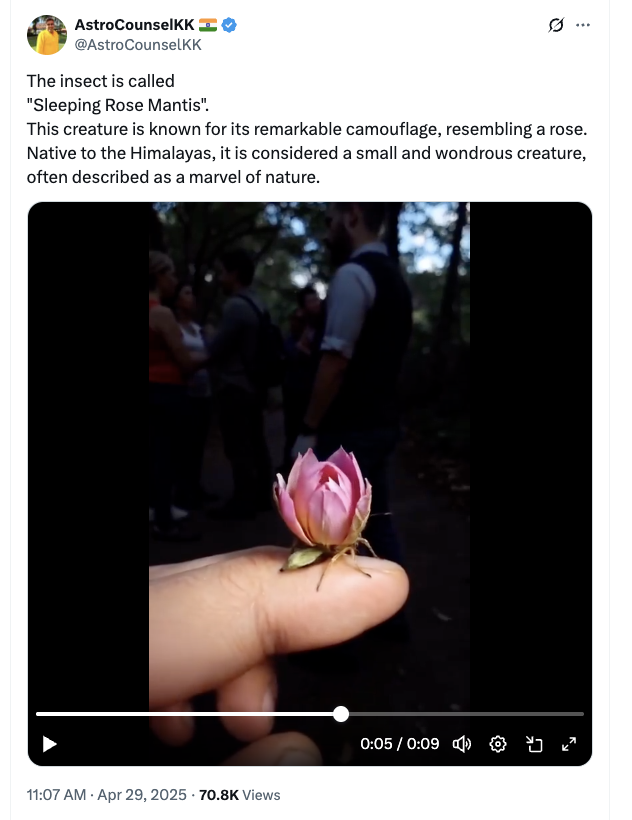
Do viral videos prove the existence of a creature named "Sleeping Rose Mantis" that transforms itself into a flower? No, that's not true: No databases of scientific literature reviewed by Lead Stories showed any mentions of such an insect. The videos were initially published by an account that mentioned generative AI tools in their descriptions.
The claim appeared in a post (archived here) on X where it was published on April 29, 2025. It opened:
The insect is called 'Sleeping Rose Mantis'. This creature is known for its remarkable camouflage, resembling a rose. Native to the Himalayas, it is considered a small and wondrous creature, often described as a marvel of nature.
This is what the post looked like on X at the time of writing:
(Source: X screenshot by Lead Stories)
The 9-second video purported to authentically show an insect unfolding its wings and transforming itself into a rose flower.
Some mantises -- for example, Orchid Mantis (archived here) -- are known for remarkable camouflage allowing them to almost seamlessly mimic plants, but "Sleeping Rose Mantis" is not one of them because it doesn't exist in nature.
The video from the post reviewed in this article originated (archived here) from an account specializing in publishing visuals of what it describes as "unbelievable creatures" (archived here). The clip in question was uploaded there on March 18, 2025, under the caption explicitly mentioning several generative AI tools, among those used to create the video:
Flux
Midjourney
Kling
Aftereffects
Elevenlabs
Hashtags below the caption additionally mentioned art and AI:
#moth #flower #forest #trail #impossiblecreatures #natgeo #pokemon #hiking #artcommunity #vfx #ai #impossible #nationalgeographic #handcam #fakemon #aiartists #shock #stablediffusion #digitalart #midjourneyart #creativecoding #aiartists #reportage #storytelling #midjourneygallery #artoftheday #conceptart #trippy
One day earlier, the same account published another video (archived here) of the same imaginary bug that later started to circulate on Instagram (archived here), Facebook (archived here) and TikTok (archived here) without a disclaimer disclosing that it was created by algorithms.
A search on Google Scholar showed no scientific literature mentioning the "Sleeping Rose Mantis":
(Source: Google Scholar screenshot by Lead Stories)
Lead Stories searched additional specialized resources: JSTOR (archived here), Sage Journals (archived here), ProQuest (archived here) and Columbia University Libraries (archived here), but found no scholarly articles mentioning the insect in question.
(Source: JSTOR screenshot by Lead Stories)
(Source: Sage Journals screenshot by Lead Stories)
(Source: ProQuest screenshot by Lead Stories)
(Source: Columbia University Libraries screenshot by Lead Stories)
Read more
Other Lead Stories fact checks of the claims concerning science are here.






















